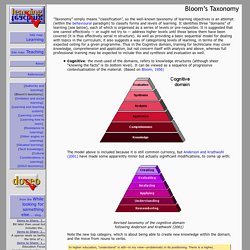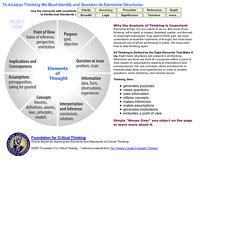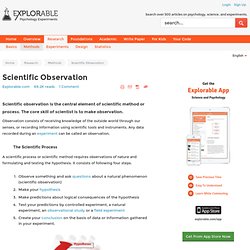

Bloom's taxonomy. "Taxonomy” simply means “classification”, so the well-known taxonomy of learning objectives is an attempt (within the behavioural paradigm) to classify forms and levels of learning.

It identifies three “domains” of learning (see below), each of which is organised as a series of levels or pre-requisites. It is suggested that one cannot effectively — or ought not try to — address higher levels until those below them have been covered (it is thus effectively serial in structure). As well as providing a basic sequential model for dealing with topics in the curriculum, it also suggests a way of categorising levels of learning, in terms of the expected ceiling for a given programme. Thus in the Cognitive domain, training for technicians may cover knowledge, comprehension and application, but not concern itself with analysis and above, whereas full professional training may be expected to include this and synthesis and evaluation as well.
Yet more Notes arising from comments: Blooms-verbs.jpg (JPEG Image, 756 × 567 pixels) When #SOLO Met Bloom Taxonomy. If you are interested in the thinking (thinking might be too strong a term for what I was actually doing) that brought me to explore this relationship you might want to look at a previous post, “Posts Move, Goals Don’t.”

Why Do Teachers Ask the Questions They Ask? Although teacher questioning has received much attention in the past few years, studies on teacher questions in the ESL classroom have so far revolved around the ‘closed’/‘open’ or ‘display’/‘referential’ distinction.

Findings from classroom observations show excessive use of closed questions by teachers in the classroom. The argument that has been more or less accepted is that such questions seek to elicit short, restricted student responses and are therefore purposeless in the classroom setting. This paper attempts to conduct an analytical discussion of the argument. The questions of three non-native ESL teachers during reading comprehension in the upper secondary school in Brunei are analysed using a three-level question construct. Through this three-level question analysis, it is possible to challenge the argument concerning question types and purposes. Thought Questions - Asking the right questions is the answer. 5 Powerful Questions Teachers Can Ask Students. My first year teaching a literacy coach came to observe my classroom.

After the students left, she commented on how I asked the whole class a question, would wait just a few seconds, and then answer it myself. "It's cute," she added. Um, I don't think she thought it was so cute. I think she was treading lightly on the ever-so shaky ego of a brand-new teacher while still giving me some very necessary feedback. So that day, I learned about wait/think time. Many would agree that for inquiry to be alive and well in a classroom that, amongst other things, the teacher needs to be expert at asking strategic questions, and not only asking well-designed ones, but ones that will also lead students to questions of their own. Keeping It Simple I also learned over the years that asking straightforward, simply-worded questions can be just as effective as those intricate ones.
. #1. This question interrupts us from telling too much. . #2. . #3. . #4. . #5. How to Encourage Higher Order Thinking. Why Use This Tip What To Do Why Use This Tip A main goal of educators today is to teach students the skills they need to be critical thinkers.

Instead of simply memorizing facts and ideas, children need to engage in higher levels of thinking to reach their fullest potential. Practicing Higher Order Thinking (HOT) skills outside of school will give kids and teens the tools that they need to understand, infer, connect, categorize, synthesize, evaluate, and apply the information they know to find solutions to new and existing problems.
After reading a book about Martin Luther King or studying the Civil Rights era, you could choose to ask a child a simple question such as “Who is Martin Luther King, Jr.?”. Critical Thinking Model 1. To Analyze Thinking We Must Identify and Question its Elemental Structures Standard: Clarityunderstandable, the meaning can be grasped Could you elaborate further?

Could you give me an example? Could you illustrate what you mean? Standard: Accuracyfree from errors or distortions, true How could we check on that? Standard: Precisionexact to the necessary level of detail Could you be more specific? Standard: Relevancerelating to the matter at hand How does that relate to the problem? Standard: Depthcontaining complexities and multiple interrelationships. Culture of thinking. Scientific Observation - Collecting Empirical Evidence. Scientific observation is the central element of scientific method or process.

The core skill of scientist is to make observation. Observation consists of receiving knowledge of the outside world through our senses, or recording information using scientific tools and instruments. Any data recorded during an experiment can be called an observation. The Scientific Process A scientific process or scientific method requires observations of nature and formulating and testing the hypothesis. Observe something and ask questions about a natural phenomenon (scientific observation) Make your hypothesis Make predictions about logical consequences of the hypothesis Test your predictions by controlled experiment, a natural experiment, an observational study or a field experiment Create your conclusion on the basis of data or information gathered in your experiment.